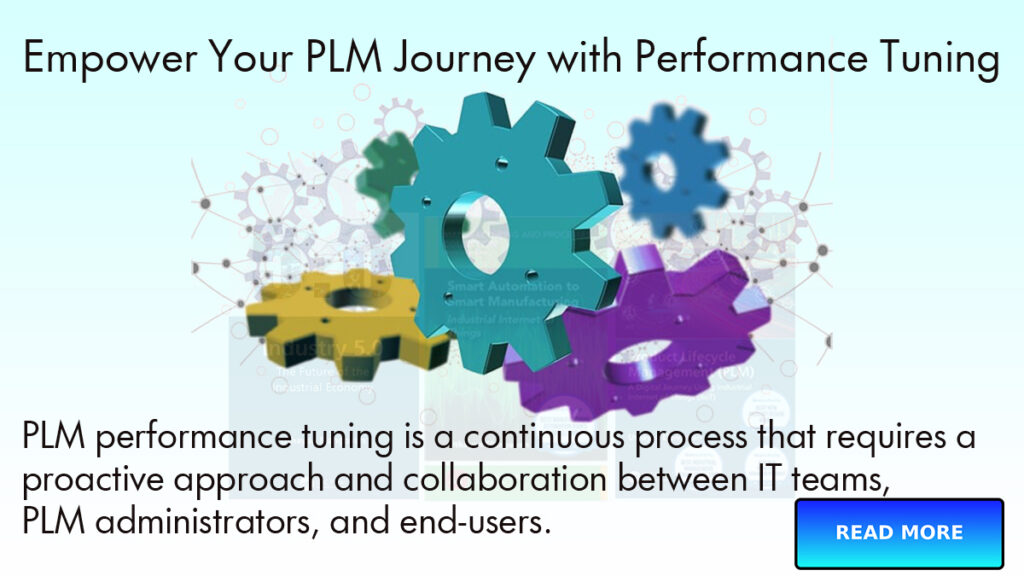Powering Productivity: Advanced PLM Performance Tuning empowers manufacturers to unlock efficiency and streamline collaboration by optimizing their PLM systems. Before diving into performance tuning, it is crucial to perform a comprehensive assessment of the PLM system’s current performance. This involves analyzing key performance indicators (KPIs) such as response times, database performance, server resource utilization, and user activity patterns. The assessment will help identify bottlenecks and areas that require improvement.
Introduction:
In the rapidly evolving world of modern manufacturing, Product Lifecycle Management (PLM) has become indispensable for fostering efficient collaboration, streamlined processes, and improved product quality. However, harnessing the full potential of PLM requires manufacturers to optimize performance across various elements, including physical hardware, VPN, cloud infrastructure, vaulting for file storage, network – LAN and WAN, and load balancers. This comprehensive article explores cutting-edge strategies and best practices for PLM performance tuning, aimed at enhancing productivity and agility. Neel SMARTEC, a renowned PLM solutions provider, encourages manufacturers to embrace these techniques and unlock the true potential of their PLM systems.

Assessing Physical Hardware and Infrastructure:
Manufacturers must meticulously plan and invest in high-performance servers with ample memory, processing power, and storage to handle the complexities of PLM data and workflows.
Utilize fast and reliable storage systems, such as Solid-State Drives (SSDs), to optimize data access times and reduce bottlenecks during file retrieval.
Embrace server virtualization to efficiently manage resources, enhance flexibility, and rapidly scale the PLM environment as the organization grows.
Enhancing VPN Performance:
Optimize VPN performance by selecting appropriate encryption protocols and VPN gateways for secure remote access to PLM systems.
Implement multi-factor authentication to ensure secure access and prevent unauthorized users from accessing sensitive PLM data.
Leveraging Cloud Infrastructure:
Migrate to cloud-based PLM solutions to leverage scalable infrastructure, flexible deployment models, and seamless access from any location or device.
Select reputable cloud providers with robust security measures and data encryption protocols to safeguard sensitive product data.
Vaulting for File Storage:
Employ distributed file vaults across multiple locations to improve data availability, reduce latency, and enhance collaboration among geographically dispersed teams.
Implement automated data replication and regular backups to ensure data integrity and disaster recovery readiness.
Optimizing Network – LAN and WAN:
Optimize Local Area Network (LAN) performance by segmenting traffic, reducing network congestion, and implementing Quality of Service (QoS) policies.
Utilize WAN optimization techniques, such as data compression and caching, to improve data transfer speeds and reduce latency in geographically distributed PLM environments.
Harnessing the Power of Load Balancers:
Deploy load balancers to evenly distribute PLM traffic across multiple servers, ensuring optimal resource utilization and improved system responsiveness.
Implement high-availability configurations to minimize downtime and maintain continuous PLM availability for critical manufacturing processes.
Conclusion:
Manufacturers face unprecedented challenges in today’s digital landscape, demanding highly efficient Advanced PLM performance Tuning. By focusing on optimizing physical hardware, leveraging VPNs, embracing cloud infrastructure, implementing vaulting for file storage, and fine-tuning LAN and WAN networks with load balancers, manufacturers can achieve remarkable improvements in PLM system performance. As a leader in PLM consulting service provider,
PLM performance tuning is a continuous process that requires a proactive approach and collaboration between IT teams, PLM administrators, and end-users.
Neel SMARTEC urges manufacturers to take proactive steps towards PLM performance tuning and elevate their competitive edge through enhanced productivity, seamless collaboration, and accelerated innovation. Embrace these advanced techniques today and unlock the true potential of your PLM system in the dynamic world of modern manufacturing. Reach out to Neel SMARTEC’s expert team to explore OpenBOM, Windchill PLM services for your unique manufacturing needs. Together, we can pave the way for a smarter, more productive future.


